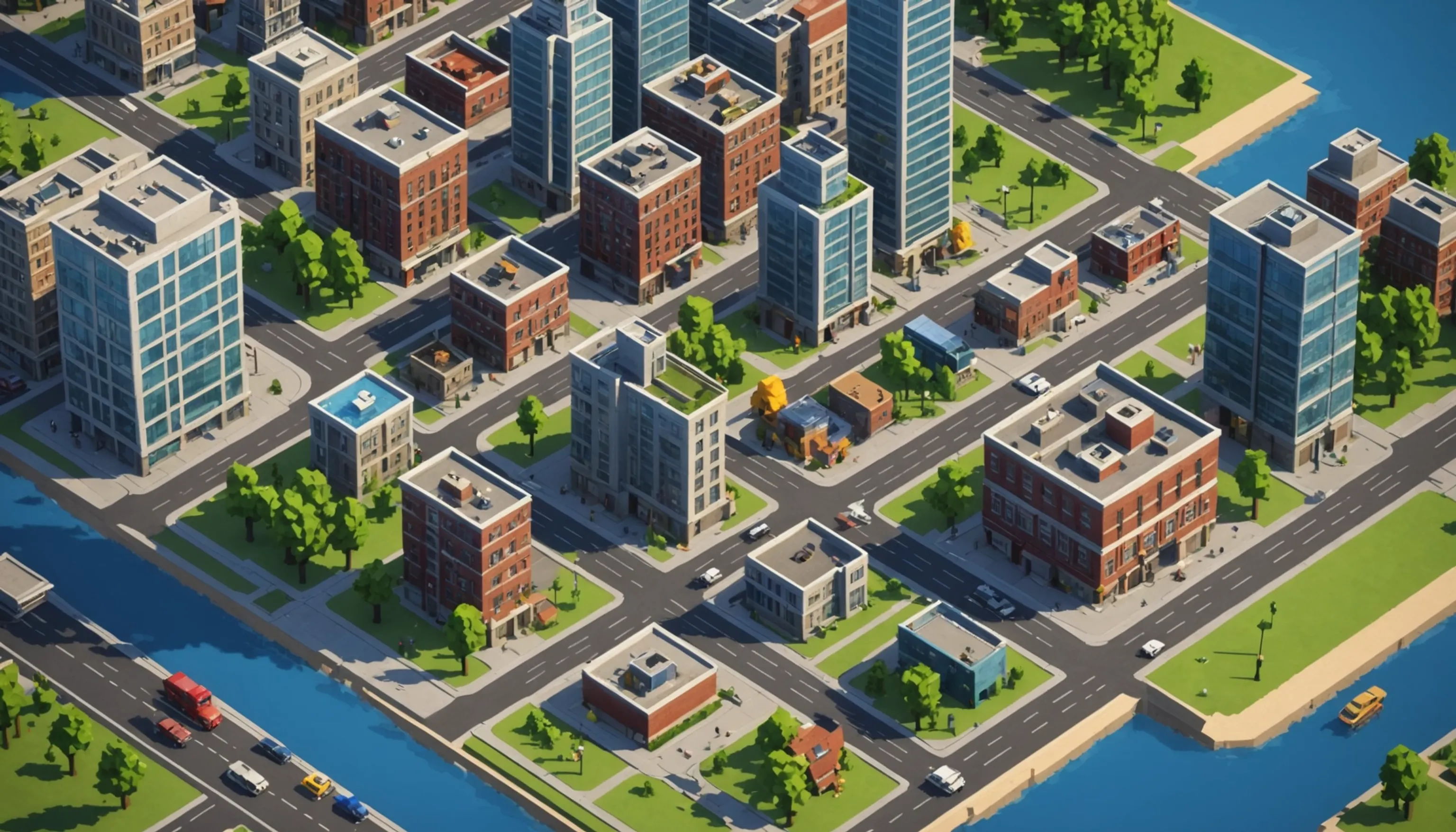City Builders with Math
 HvWHenry van Wagenberg
HvWHenry van Wagenberg
Using City Builders to Teach Math Concepts
City builders serve as a unique platform for teaching math concepts to teenagers. By engaging in the design and management of virtual cities, students can apply mathematical principles in real-world scenarios. These games allow users to explore essential math skills, such as geometry for shaping structures, arithmetic for managing resources, and algebra for planning development.
Through interactive gameplay, teens can visualize math problems, making abstract concepts more tangible. This hands-on approach not only enhances understanding but also fosters a greater interest in math, showing students the practical applications of what they learn in school.
Benefits of City Builders in Math Education
Integrating city builders into math education offers numerous benefits that enhance students' learning experiences. Firstly, these games create an engaging environment where teenagers can explore mathematical concepts through interactive play. This immersive approach helps students retain information better compared to traditional teaching methods.
Furthermore, city builders promote critical thinking and problem-solving skills. As players design and manage their cities, they must analyze various factors, such as budget constraints and resource allocation, which requires the application of basic arithmetic and strategic planning. This hands-on experience allows students to see the consequences of their decisions, reinforcing the importance of math in real-life scenarios.
Additionally, city builders foster collaboration and teamwork. Many games encourage players to work together, facilitating group projects where they can share ideas and strategies. This social aspect not only enhances communication skills but also allows students to learn from one another, making math a shared experience rather than an isolated one.
Moreover, city builders can cater to various learning styles. Visual learners can benefit from the graphics and spatial layouts, while auditory learners can engage with sounds and narrative elements. This adaptability ensures that all students can find value in the gaming experience, making math more accessible and enjoyable.
In summary, using city builders in math education cultivates a dynamic learning environment that builds essential skills while making math fun and relevant for teenagers.
Engaging Teenagers through Interactive Learning
Engaging teenagers through interactive learning is crucial in today’s educational landscape, and city builders provide a perfect platform for this approach. Unlike traditional learning methods, which often rely on rote memorization, interactive learning encourages students to actively participate in their education. City builders allow teenagers to immerse themselves in a virtual environment where they can experiment with various mathematical concepts while having fun.
One significant aspect of interactive learning is its ability to cater to different learning styles. For instance, visual learners benefit from the graphical representations of cities, while kinesthetic learners engage through hands-on activities as they manipulate resources and structures. This variety ensures that all students find a way to connect with the material, making math more appealing and relatable.
Moreover, city builders foster a sense of ownership and agency in learning. As students design their cities and make decisions about resource allocation, they experience the consequences of their choices firsthand. This practical application of math enhances their understanding and retention of concepts, as they can see the real-world implications of their decisions.
Additionally, the competitive and goal-oriented nature of city builders can motivate teenagers to improve their math skills. As they strive to create the most efficient or appealing city, they become more invested in learning the underlying math concepts necessary to succeed. By transforming math education into an engaging experience, city builders can significantly enhance teenagers' motivation and interest in mathematics.

Key Math Skills Developed with City Builders
City builders are excellent tools for developing essential math skills among teenagers. These games enhance geometry skills as players design buildings and layouts, fostering spatial awareness. Additionally, city builders require basic arithmetic for budgeting and resource management, helping students practice calculations in real-world contexts.
Moreover, players often engage with algebra when planning expansions and optimizing city layouts. By solving problems and making strategic decisions, teens sharpen their critical thinking and analytical skills. Overall, city builders create a fun and interactive way for students to develop vital math skills while enjoying the learning process.
Geometry and Spatial Awareness
Geometry and spatial awareness are vital math skills that city builders uniquely enhance. In these interactive environments, teenagers are tasked with designing and constructing various structures, from residential homes to complex transportation systems. This process requires a solid understanding of geometric principles, as players must consider shapes, dimensions, and angles while planning their cities.
As players engage in city building, they visualize how different structures fit together within a given space. This hands-on experience not only deepens their comprehension of geometric concepts but also fosters strong spatial reasoning skills. For instance, when designing a park or arranging buildings, students must think critically about how each element interacts with others in the environment, enhancing their ability to perceive and manipulate space.
Furthermore, city builders often incorporate various challenges that require players to optimize layouts for efficiency. This could involve maximizing space or ensuring that roads are accessible for all citizens. Such tasks encourage teenagers to experiment with different configurations, testing hypotheses and refining their designs based on outcomes. This iterative process mirrors real-world architectural and engineering challenges, making math relevant and applicable.
Additionally, the visual nature of city builders allows students to see the immediate impact of their design choices, reinforcing their understanding of geometry in a practical context. By developing these skills in a fun and engaging way, city builders help teenagers build a strong foundation in geometry and spatial awareness that will serve them well in future studies and careers.
Basic Arithmetic in Resource Management
Basic arithmetic plays a crucial role in resource management within city builders, making it an essential skill for teenagers to develop. In these games, players must manage various resources, such as money, materials, and workforce, to create thriving cities. This requires frequent calculations that involve addition, subtraction, multiplication, and division.
For instance, as players construct new buildings or upgrade existing ones, they need to determine the cost of materials and labor. Understanding how to accurately add expenses ensures that they stay within budget, which is vital for maintaining a successful city. Additionally, players must calculate the potential income generated from taxes or businesses, weighing it against their expenses to make informed decisions about expansion.
Resource allocation also involves basic arithmetic, as players decide how to distribute limited resources effectively. They might need to calculate how many workers to assign to different tasks or how much energy their city consumes versus what it generates. This kind of critical thinking not only enhances arithmetic skills but also fosters a sense of responsibility and strategic planning.
Moreover, the interactive nature of city builders makes learning arithmetic engaging. By seeing the direct consequences of their calculations, teenagers can appreciate the importance of math in real-world scenarios, such as budgeting and financial planning. This practical application of basic arithmetic in resource management helps students develop strong foundational skills that will benefit them in both academic and everyday situations.

Algebra in Planning and Development
Algebra is a fundamental skill that city builders leverage to enhance planning and development processes, making it essential for teenagers engaged in these games. In the context of city building, algebraic principles help players formulate and solve equations related to various aspects of their virtual cities, such as population growth, resource consumption, and infrastructure demands.
For example, when players plan for city expansion, they often need to predict future population growth based on current trends. This involves using variables to represent different factors, allowing students to create equations that model potential outcomes. By manipulating these equations, teenagers can see how changes in one variable, such as increasing housing, affect others, like population density or resource needs.
Additionally, city builders frequently require players to optimize their designs, which often involves algebraic thinking. Players might need to balance budgets while maximizing city efficiency, leading them to set up inequalities that represent constraints and goals. This challenge encourages students to think critically about how to achieve their objectives while adhering to mathematical principles.
Furthermore, the iterative nature of city planning allows players to test different scenarios and equations, reinforcing their understanding of algebra through practical application. As they engage with these mathematical concepts, teenagers develop problem-solving skills and a deeper appreciation for the relevance of algebra in real-world situations, such as urban planning and resource management. Through city builders, algebra becomes more than just theoretical knowledge; it transforms into a powerful tool for effective decision-making and strategic development.
Popular City Builder Games for Learning Math
Several popular city builder games effectively teach math concepts while providing an engaging experience for teenagers. One of the most recognized is SimCity, a classic that allows players to create and manage their own cities. This game emphasizes resource management, budgeting, and spatial planning, making it a rich platform for learning math.
Another excellent choice is Cities: Skylines, which offers advanced city planning challenges. Players must consider factors like population growth and infrastructure costs, applying geometry and algebra in real-time scenarios.
Minecraft also stands out, particularly in Creative Mode, where players can build structures while experimenting with geometric shapes and spatial awareness. The game encourages creativity alongside mathematical thinking.
These games not only make math enjoyable but also demonstrate its real-world applications, helping teenagers develop essential skills while having fun.
SimCity: A Classic City Builder
SimCity stands as a classic in the world of city builder games, renowned for its engaging gameplay and educational value. Since its inception in 1989, SimCity has allowed players to create and manage their own cities, providing a rich platform for learning various math concepts. One of the key features of the game is its focus on resource management, where players must balance budgets while addressing the needs of their virtual citizens.
In SimCity, players are tasked with making decisions that impact the economic and social aspects of their cities. This requires the application of basic arithmetic to track income from taxes and expenses for services such as police, fire departments, and education. As players expand their cities, they must use geometry to plan road layouts and building placements, enhancing their spatial awareness.
Moreover, SimCity introduces elements of algebra as players analyze data and forecast future growth. They need to understand how changes in one area, like increasing the number of parks, can affect population happiness and, consequently, tax income. This connection between actions and outcomes reinforces the practical application of math in real-life scenarios.
Overall, SimCity not only entertains but also educates players on the importance of strategic planning, critical thinking, and math skills, making it a timeless tool for engaging teenagers in learning.
Cities: Skylines for Advanced Planning
Cities: Skylines is an advanced city builder game that has gained immense popularity for its depth and realism, making it an excellent tool for teaching math concepts to teenagers. Released in 2015, this game takes city planning to a new level, challenging players to manage intricate systems of roads, transportation, and public services while balancing budgets and meeting the needs of their citizens.
One of the standout features of Cities: Skylines is its emphasis on resource management, which requires players to apply basic arithmetic to track income and expenditures. As players expand their cities, they must budget effectively, ensuring they have enough funds for essential services like education, healthcare, and public safety. This financial aspect encourages an understanding of economic principles and the importance of fiscal responsibility.
Moreover, the game incorporates elements of geometry and algebra as players design layouts for optimal traffic flow and zoning. Players must calculate the best locations for residential, commercial, and industrial areas, considering the impact on overall city efficiency. By analyzing data and making adjustments, players learn to solve complex problems and optimize their cities.
In addition, Cities: Skylines encourages creativity and innovation, as players can experiment with different designs and strategies. This combination of math, creativity, and critical thinking makes Cities: Skylines an invaluable resource for educators looking to engage teenagers in learning while having fun.
Minecraft: Building with Math in Creative Mode
Minecraft has transcended its status as a popular video game to become a valuable educational tool, especially in its Creative Mode. This mode allows players to build and explore without limitations, providing a unique opportunity to engage with mathematical concepts in an interactive and enjoyable way.
In Creative Mode, players can utilize various geometric shapes to construct complex structures, fostering a strong understanding of geometry. Here’s how Minecraft encourages math learning:
- Spatial Awareness: Players must visualize how different blocks fit together, enhancing their ability to perceive space and dimensions.
- Measurement: Constructing buildings and landscapes requires players to measure distances and calculate areas, reinforcing their understanding of area and volume.
- Symmetry and Patterns: Many players create intricate designs, which involves understanding symmetry and recognizing patterns, essential skills in geometry.
- Problem Solving: Players often encounter challenges that require them to think critically and apply mathematical reasoning to find solutions.
Furthermore, the collaborative nature of Minecraft encourages teamwork, as players can work together on ambitious projects. This collaboration enhances communication skills while allowing students to share ideas and strategies.
Overall, Minecraft’s Creative Mode provides a hands-on environment where teenagers can explore mathematical concepts in a fun and engaging manner, making math relevant to their interests and creativity.
